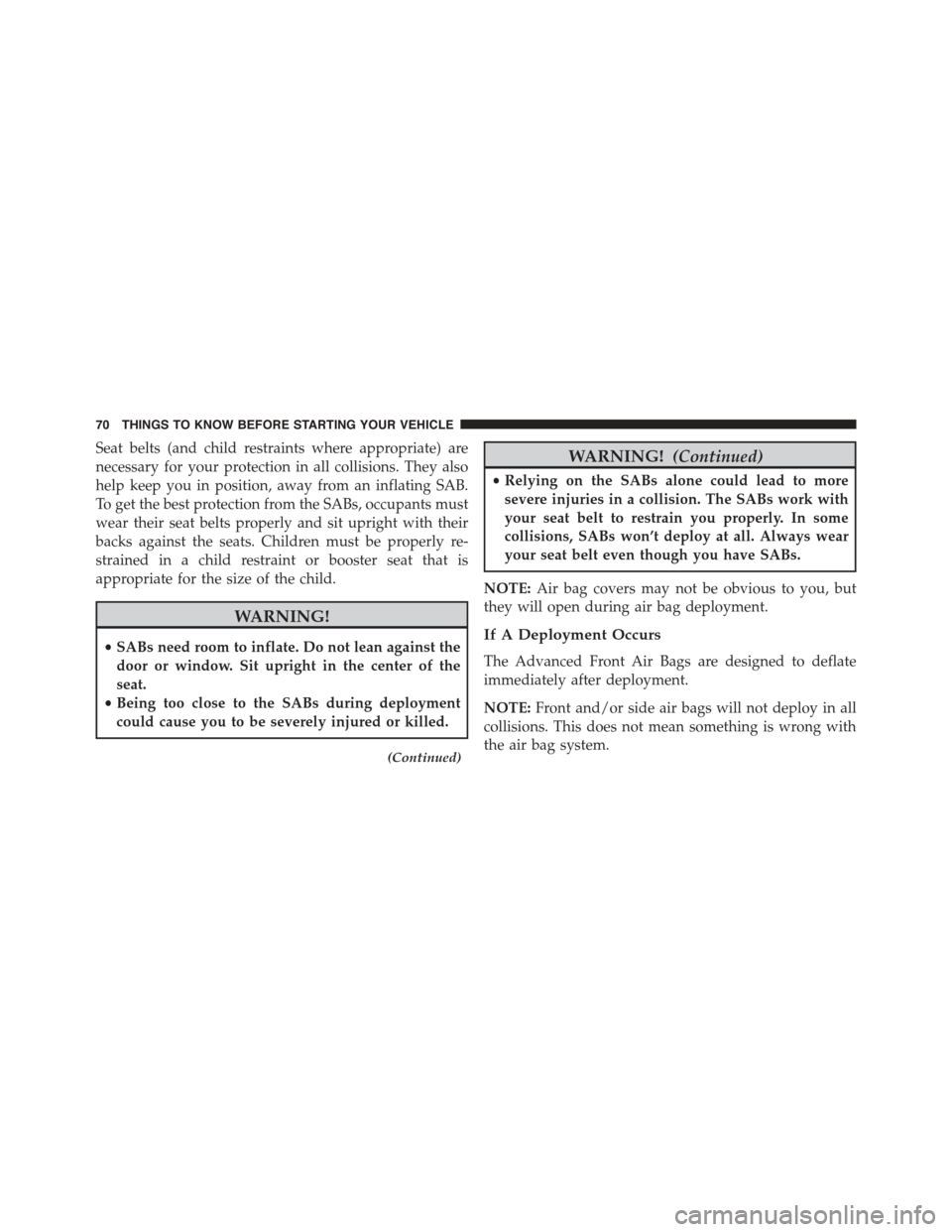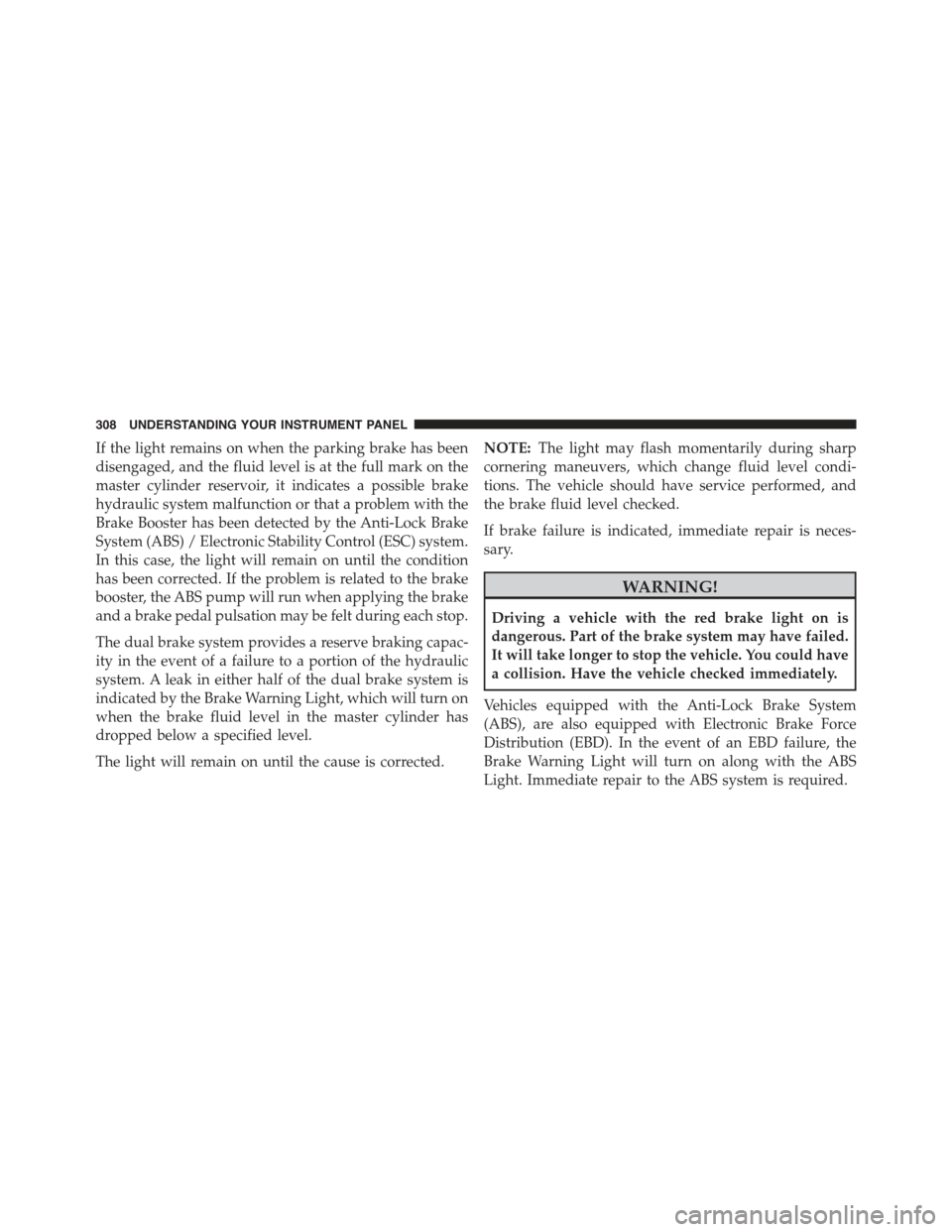2015 JEEP WRANGLER ABS
[x] Cancel search: ABSPage 23 of 695

the instrument cluster) will flash rapidly for about 16
seconds to signal that the Vehicle Security Alarm is
arming. During this 16-second arming period, opening
any door or the swing gate will cancel the arming. If the
Vehicle Security Alarm is successfully set, the Vehicle
Security Light will flash at a slower rate to indicate the
Vehicle Security Alarm is armed.
To Disarm The System
To disarm the Vehicle Security Alarm, you will need to
push the UNLOCK button on the RKE transmitter, or
turn the ignition switch to the ON/RUN position. If
something has triggered the Vehicle Security Alarm in
your absence, the horn will sound three times and the
exterior lights blink three times when you unlock the
doors. Check the vehicle for tampering.
The Vehicle Security Alarm is designed to protect your
vehicle; however, you can create conditions where the
Vehicle Security Alarm will arm unexpectedly. If you
remain in the vehicle and lock the doors with the RKE
transmitter, once the Vehicle Security Alarm is armed
(after 16 seconds), when you pull the door handle to exit,
the alarm will sound. If this occurs, push the UNLOCK
button on the RKE transmitter to disarm the Vehicle
Security Alarm. You may also accidentally disarm the
Vehicle Security Alarm by unlocking the driver’s door
with the key and then locking it. The door will be locked
but the Vehicle Security Alarm will not arm.
NOTE:
•Unlocking the doors with the manual door lock plung-
ers or the driver’s door lock cylinder will not disarm
the Vehicle Security Alarm.
•When the Vehicle Security Alarm is armed, the interior
power door lock switches will not unlock the doors.
2
THINGS TO KNOW BEFORE STARTING YOUR VEHICLE 21
Page 70 of 695

Knee Impact Bolsters
The Knee Impact Bolsters help protect the knees of the
driver and front passenger, and position the front occu-
pants for improved interaction with the Advanced Front
Air Bags.
WARNING!
•Do not drill, cut, or tamper with the knee impact
bolsters in any way.
•Do not mount any accessories to the knee impact
bolsters such as alarm lights, stereos, citizen band
radios, etc.
Supplemental Seat-Mounted Side Air Bags (SABs)
Your vehicle is equipped with Supplemental Seat-
Mounted Side Air Bags (SABs) that are located in the
outboard side of the front seats. The SABs are marked
with a SRS AIRBAG or AIRBAG label sewn into the
outboard side of the seats. The SABs may help to reduce
the risk of occupant injury during certain side impacts, in
addition to the injury reduction potential provided by the
seat belts and body structure.
When the SAB deploys, it opens the seam on the out-
board side of the seatback’s trim cover. The inflating SAB
Supplemental Seat-Mounted Side Air Bag Location
68 THINGS TO KNOW BEFORE STARTING YOUR VEHICLE
Page 71 of 695

deploys through the seat seam into the space between the
occupant and the door. The SAB moves at a very high
speed and with such a high force that it could injure you
if you are not seated properly, or if items are positioned
in the area where the SAB inflates. Children are at an
even greater risk of injury from a deploying air bag.
WARNING!
Do not use accessory seat covers or place objects
between you and the Side Air Bags; the performance
could be adversely affected and/or objects could be
pushed into you, causing serious injury.
SABs are designed to activate in certain side impacts. The
Occupant Restraint Controller (“ORC”) determines
whether the deployment of the SAB in a particular
impact event is appropriate, based on the severity and
type of collision. The side impact sensors aid the ORC in
determining the appropriate response to impact events.
The system is calibrated to deploy the SAB on the impact
side of the vehicle during impacts that require SAB
occupant protection. In side impacts, the SABs deploy
independently; a left side impact deploys the left SAB
only and a right side impact deploys the right side SAB
only. Vehicle damage by itself is not a good indicator of
whether or not SABs should have deployed.
The SABs will not deploy in all side collisions, including
some collisions at certain angles, or some side collisions
that do not impact the area of the passenger compart-
ment.
SABs are a supplement to the seat belt restraint system.
SABs deploy in less time than it takes to blink your eyes.
Occupants, including children, who are up against or very
close to SABs can be seriously injured or killed. Occupants,
including children, should never lean on or sleep against
the door, side windows, or area where the SABs inflate,
even if they are in an infant or child restraint.
2
THINGS TO KNOW BEFORE STARTING YOUR VEHICLE 69
Page 72 of 695

Seat belts (and child restraints where appropriate) are
necessary for your protection in all collisions. They also
help keep you in position, away from an inflating SAB.
To get the best protection from the SABs, occupants must
wear their seat belts properly and sit upright with their
backs against the seats. Children must be properly re-
strained in a child restraint or booster seat that is
appropriate for the size of the child.
WARNING!
•SABs need room to inflate. Do not lean against the
door or window. Sit upright in the center of the
seat.
•Being too close to the SABs during deployment
could cause you to be severely injured or killed.
(Continued)
WARNING!(Continued)
•Relying on the SABs alone could lead to more
severe injuries in a collision. The SABs work with
your seat belt to restrain you properly. In some
collisions, SABs won’t deploy at all. Always wear
your seat belt even though you have SABs.
NOTE:Air bag covers may not be obvious to you, but
they will open during air bag deployment.
If A Deployment Occurs
The Advanced Front Air Bags are designed to deflate
immediately after deployment.
NOTE:Front and/or side air bags will not deploy in all
collisions. This does not mean something is wrong with
the air bag system.
70 THINGS TO KNOW BEFORE STARTING YOUR VEHICLE
Page 310 of 695

If the light remains on when the parking brake has been
disengaged, and the fluid level is at the full mark on the
master cylinder reservoir, it indicates a possible brake
hydraulic system malfunction or that a problem with the
Brake Booster has been detected by the Anti-Lock Brake
System (ABS) / Electronic Stability Control (ESC) system.
In this case, the light will remain on until the condition
has been corrected. If the problem is related to the brake
booster, the ABS pump will run when applying the brake
and a brake pedal pulsation may be felt during each stop.
The dual brake system provides a reserve braking capac-
ity in the event of a failure to a portion of the hydraulic
system. A leak in either half of the dual brake system is
indicated by the Brake Warning Light, which will turn on
when the brake fluid level in the master cylinder has
dropped below a specified level.
The light will remain on until the cause is corrected.
NOTE:The light may flash momentarily during sharp
cornering maneuvers, which change fluid level condi-
tions. The vehicle should have service performed, and
the brake fluid level checked.
If brake failure is indicated, immediate repair is neces-
sary.
WARNING!
Driving a vehicle with the red brake light on is
dangerous. Part of the brake system may have failed.
It will take longer to stop the vehicle. You could have
a collision. Have the vehicle checked immediately.
Vehicles equipped with the Anti-Lock Brake System
(ABS), are also equipped with Electronic Brake Force
Distribution (EBD). In the event of an EBD failure, the
Brake Warning Light will turn on along with the ABS
Light. Immediate repair to the ABS system is required.
308 UNDERSTANDING YOUR INSTRUMENT PANEL
Page 311 of 695

Operation of the Brake Warning Light can be checked by
turning the ignition switch from the OFF position to the
ON/RUN position. The light should illuminate for ap-
proximately two seconds. The light should then turn off
unless the parking brake is applied or a brake fault is
detected. If the light does not illuminate, have the light
inspected by an authorized dealer.
The light also will turn on when the parking brake is
applied with the ignition switch in the ON/RUN posi-
tion.
NOTE:This light shows only that the parking brake is
applied. It does not show the degree of brake application.
11. High Beam Indicator
This indicator shows that the high beam head-
lights are on. Push the multifunction control lever
away from you to switch the headlights to high beam.
Pull the lever toward you to switch the headlights back to
low beam. If the driver’s door is open, and the headlights
or park lights are left on, the high beam indicator light
will remain illuminated and a chime will sound.
12. Anti-Lock Brake (ABS) Light
After the ignition is turned on, the Anti-Lock
Brake System (ABS) light illuminates to indicate
function check at vehicle startup. If the light remains on
after startup or comes on and stays on at road speeds, it
may indicate that the ABS has detected a malfunction or
has become inoperative. The system reverts to standard
non-anti-lock brakes.
If both the Brake Warning Light and the ABS Warning
Light are on, see an authorized dealer immediately. Refer
to “Anti-Lock Brake System” in “Starting And
Operating”.
4
UNDERSTANDING YOUR INSTRUMENT PANEL 309
Page 419 of 695

!BRAKE SYSTEM.......................468
!ELECTRONIC BRAKE CONTROL SYSTEM . . . .469
▫Anti-Lock Brake System (ABS)............469
▫Traction Control System (TCS)............471
▫Brake Assist System (BAS)...............471
▫Hill Start Assist (HSA).................472
▫Electronic Roll Mitigation (ERM)..........476
▫Electronic Stability Control (ESC)..........477
▫ESC Activation/Malfunction Indicator Light And
ESC OFF Indicator Light................483
▫Trailer Sway Control (TSC)..............484
▫Hill Descent Control (HDC) — If Equipped . . .485
!TIRE SAFETY INFORMATION.............487
▫Tire Markings........................487
▫Tire Identification Number (TIN)...........490
▫Tire Terminology And Definitions..........492
▫Tire Loading And Tire Pressure...........493
!TIRES — GENERAL INFORMATION........498
▫Tire Pressure........................498
▫Tire Inflation Pressures.................500
▫Tire Pressures For High Speed Operation . . . .501
▫Radial Ply Tires......................501
▫Tire Types...........................502
▫Run Flat Tires — If Equipped.............504
▫Spare Tires — If Equipped...............504
▫Tire Spinning........................507
5
STARTING AND OPERATING 417
Page 471 of 695

In the event power assist is lost for any reason (for
example, repeated brake applications with the engine
OFF) the brakes will still function. The effort required to
brake the vehicle will be much greater than that required
with the power system operating.
ELECTRONIC BRAKE CONTROL SYSTEM
Your vehicle is equipped with an advanced electronic
brake control system that includes Anti-Lock Brake Sys-
tem (ABS), Traction Control System (TCS), Brake Assist
System (BAS), Hill Start Assist (HSA), Electronic Roll
Mitigation (ERM), Electronic Stability Control (ESC),
Trailer Sway Control (TSC), and Hill Descent Control
(HDC). All of these systems work together to enhance
vehicle stability and control in various driving condi-
tions, and are commonly referred to as ESC.
Anti-Lock Brake System (ABS)
The Anti-Lock Brake System (ABS) is designed to aid the
driver in maintaining vehicle control under adverse
braking conditions. The system operates with a separate
computer to modulate hydraulic pressure to prevent
wheel lock-up and help avoid skidding on slippery
surfaces.
All vehicle wheels and tires must be the same size and
type, and tires must be properly inflated to produce
accurate signals for the computer.
WARNING!
Significant over or under-inflation of tires, or mixing
sizes of tires or wheels on the vehicle can lead to loss
of braking effectiveness.
5
STARTING AND OPERATING 469